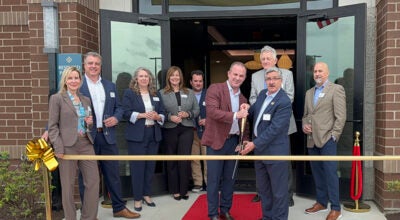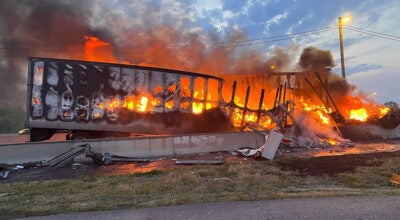Hospitals report increased cases, but shortages in supplies, personnel
Published 9:58 pm Monday, August 3, 2020
|
Getting your Trinity Audio player ready...
|
Hospital administrators reported staffing and supply shortages that are putting strains on testing and treating people for COVID-19 while cases increase across Hampton Roads, though they said there are lower numbers of more serious cases that require intensive care or ventilator treatment.
In a conference call July 28 with Sen. Mark Warner, administrators from Sentara Healthcare, Bon Secours, Riverside Health System and Chesapeake Regional Healthcare shared their concerns about their operations while asking for federal assistance in getting more personal protective equipment and the drug remdesivir.
The meeting with Warner came just hours before Gov. Ralph Northam announced new restrictions on gatherings, alcohol sales and restaurant operations in the Hampton Roads area.
Reese Jackson, president of Chesapeake Regional Healthcare, said Chesapeake General Hospital had 59 patients with COVID-19, with 14 in ICU — 12 of those on ventilators.
“We’ve seen an increase in acuity in the past week or two as well as an increase in volume,” Jackson said.
In the Eastern Region, which includes Suffolk and all of Hampton Roads, hospitals have 554 COVID-19 patients as of July 29, according to Virginia Department of Health data, and 2,386 total patients. Those hospitals have a staffed bed capacity of 3,348 and a surge capacity of 4,018 beds.
The region has 41% of the state’s COVID-19 patients. More than half of all state residents on ventilators, 81 out of 155, are from the region. Just over 45% of state residents in intensive care with COVID-19 come from the Eastern Region.
Riverside Health System President and Chief Executive Officer Mike Doucette said its five Hampton Roads hospitals are seeing significant increases in COVID-19 patients over the past few weeks, especially in the last two weeks. It has about 50 patients at its hospitals who have COVID-19, and they are seeing increasing numbers of people with COVID-19 at its urgent care facilities. It has seen an “exponential” increase in the last 10 days of people with COVID-19-like symptoms. Percent positives at its facilities has increased from 4% to nearly 11% in two weeks.
Amy Carrier, Bon Secours Virginia president, said 44% of its ICUs are full, and 28% of its ventilators are available for use. She said its hospitals in Portsmouth, Norfolk and points east are seeing higher numbers of COVID-19 patients, more than in areas such as Franklin or Newport News.
“We have seen our numbers here in Hampton Roads increasing,” Carrier said, “however, really not to the point that they’ve stressed our capacity in terms of our bed availability, or, in particular, our critical care or ventilator capacity within our ICUs.”
At Sentara Healthcare hospitals in the region, vice president and chief quality safety officer Joel Bundy said its largest COVID-19 admissions are coming from its hospitals in South Hampton Roads, about 300 overall in the past two weeks. However, Sentara hospitals are not seeing as many patients needing to go to ICUs or go on ventilators.
“We’re seeing our numbers go up for admissions,” Bundy said, “but the severity, we seem to have a better check on that.”
All of the region’s hospitals are running into testing issues and are having to ration tests — providing them only to those showing symptoms of COVID-19. For Chesapeake Regional Medical Center and other hospitals, the issue has been coming up with enough re-agents to administer the tests.
Jackson said the state health department does well in maximizing the use of its lab, especially with contact tracing, “but they’ve been challenged as well.”
Other hospitals in the region reported similar issues with testing.
At Bon Secours, Carrier said it has some in-house testing capabilities and is trying to expand it, but like others, is trying to conserve its resources for those “who have the most acute need.” She said a run on testing taxed its resources and led to an increase in turnaround times, but noted that had improved recently.
Doucette said the turnaround time with sending tests out to Lab Corp — 10 to 11 days — makes the tests “not worth sending.”
The community spread of COVID-19 is also affecting staffing at all of the region’s hospitals. At Chesapeake Regional Healthcare, which operates two hospitals — Chesapeake Regional Medical Center and Outer Banks Hospital — Jackson said it has at least 70 employees who are not currently available to work. At least half are direct patient care employees.
“We’re definitely a hotspot now, and we’re feeling it,” Jackson said.
Doucette said Riverside has 126 employees who are out due to quarantine, though not all of them have tested positive for COVID-19. Some, he said, are due to high-risk exposures.
Bundy said that with 150 Sentara employees — mainly nurses — who are out on quarantine, it compounds a staffing issue. He said even with fewer employees, it has to still provide the same high level of care. Contact tracing for employees who get COVID-19 is difficult, he said, because of their exposure outside of the workplace.
Doucette said Riverside has successfully treated COVID-19 patients with remdesivir, saying it reduces the chances of a patient dying by 30-40%, but it has just 20% of the drug that it needs.
“if we could treat every patient with remdesivir, length of stay would go down, resources would go down, we could save lives,” Doucette said. “But that’s just not available because of the shortages.”
Carrier said Bon Secours, like Riverside, has had success using remdesivir to treat patients, and has also had success using convalescent plasma. The hospital is in need of more recovered COVID-19 patients to donate.
With other supplies, such as N95 masks and respirators, Bundy said they struggle to get enough. Chesapeake Regional Healthcare has faced a similar issue. Its chief operating officer and chief purchasing officer Amber Hudson, said its PPE burn rate has tripled in the past three weeks with the need to open up more COVID-19 units. It received a PPE supply from the national stockpile, but they are not usable, she said, due to disintegration of the ear loop piece of the mask. Riverside’s Doucette said it has not had as many issues with PPE because it has a larger purchasing system, and it has invested in a Texas company to help in that effort.
“With our burn rate tripled and our peak census continuing to grow week-by-week, we are going to quickly run through (the supply) that we have,” Hudson said. “So we’re trying not to get into that situation.”
The region’s hospital systems said the pandemic has been financially troublesome for them, with Riverside and Bon Secours officials calling it devastating.
Warner said he is working on legislation to increase testing capacity and financial assistance to hospitals. He said the federal government’s response to COVID-19 has been a failure.
“What you’ve told me will guide me as we get into these negotiations,” Warner said. “I hear the messages. We need more testing capacity. I think there is some general agreement on that. Some of this is not a case of monies. Some of this is just a case of ramping up the capability even with additional money.”






